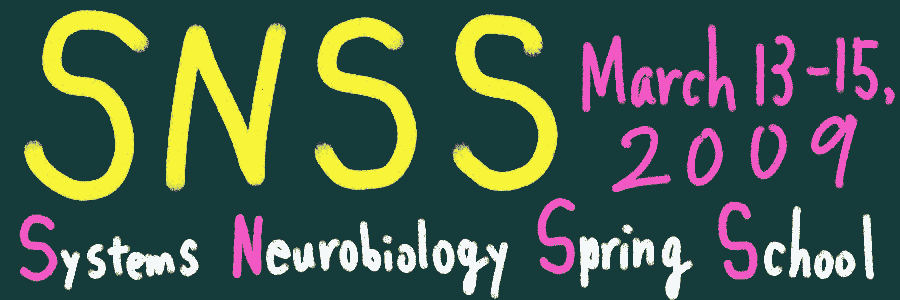



Speaker Dr. Mathew E. Diamond
Title Neuronal encoding of tactile sensation and category
Asbtract
Though sensory receptors collect physical quantities (wavelengths, frequency spectra, vibrations), we somehow perceive things (objects and categories) rather than sets of parameters. Categorical representations guide our actions on-line and form our subjective experiences and memories. How is brain activity transformed from a representation of physical parameters to a representation of meaningful objects and categories? I cannot supply you the complete answer in two hours (and probably not in 10 years!) but I will explain our approach to the problem. Our research focuses on the sense of touch in the rat’s whisker system. Tactile perception is both accurate and rapid. In the dark, rats can extract shape, position, texture and other features from just a few touches – as little as 100 ms between first contact and decision. It offers one of the best opportunities for weaving a seamless continuum from cells to behavior. We have worked mostly on texture perception. I will describe how whiskers interact with surfaces, how the whisker motion is transformed into neuronal spike trains that comprise the neuronal code of texture. Then, we follow the signals to higher-order areas like the hippocampus. Here, neuronal activity encodes the behavioral significance of the sensory event. We will see how the behavior is stored into the rat’s memory.
*Essential
von Heimendahl M, Itskov PM, Arabzadeh E, Diamond ME, "Neuronal Activity in Rat Barrel Cortex Underlying Texture Discrimination." PLoS Biol.5(2007):2696-2708.Z
*Essential
Arabzadeh E, Zorzin E, and Diamond ME, "Neuronal Encoding of Texture in the Whisker Sensory Pathway." PLoS Biol.3(2005):155-165.
*Essential
Arabzadeh E, Petersen RS, and Diamond ME "Encoding of Whisker Vibration by Rat Barrel Cortex Neurons: Implications for Texture Discrimination." J. Neurosci.23(2003):9146 –9154.
*Recommend
Harris JA, Petersen RS, and Diamond ME, "Distribution of Tactile Learning and its Neural Basis." Proc. Natl. Acad. Sci. USA. 96 (1999): 7587-7591.
*Optional – just for fun
Diamond ME, Heimendahl M, Itskov P, and Arabzadeh E, "Response to: Ritt et al., "Embodied Information Processing: Vibrissa Mechanics and Texture Features Shape Micromotions in Actively Sensing Rats" " Neuron 57 (2008): 599–613.
Speaker Dr. Tomoki Fukai
Title Information coding with excitation-inhibition balance
Abstract
In vivo cortical neurons exhibit highly irregular spike trains, which presumably reflect the stochastic nature of synaptic input. Several recent experiments have revealed that cortical (and some other) neurons receive balanced excitatory and inhibitory synaptic input, which can produce large fluctuations in the postsynaptic potential. After providing the basics of information theory and stochastic process, I will demonstrate two examples of neuronal systems that use balanced or fluctuating synaptic input for representing information in a rate-based or a synchrony-based coding scheme. The first example shows, experimentally and computationally, that single cortical neurons can maintain the degree of irregularity in output spikes at different firing rates, when they are driven by balanced synaptic input. This constancy of firing irregularity improves the reliability of rate-based information decoding. In the second example, I show in a computational model that partially-correlated input spikes with excitation-inhibition balance may achieve “perfect” temporal integration, which is non-leaky and accurate integration of external input. Perfect temporal integration has been suggested in various cognitive tasks including decision making.
Reference
*Essential
Miura K, Tsubo Y, Okada M, Fukai T "Balanced excitatory and inhibitory inputs to cortical neurons decouple firing irregularity from rate modulations." J Neurosci 27(2007):13802-13812.
*Essential
Okamoto H, Isomura Y, Takada M, Fukai T "Temporal integration by stochastic recurrent network dynamics with bimodal neurons." J Neurophysiol 97(2007):3859-3867.
*Recommended
Shu Y, Hasenstaub A, McCormick DA "Turning on and off recurrent balanced cortical activity." Nature 423(2003):288-293.
*Recommended
Miura K, Okada M, Amari S
"Estimating spiking irregularities under changing environments." Neural Comput 18(2006):2359-2386.
*Recommended
Reddi BA, Carpenter RH
"The influence of urgency on decision time." Nat Neurosci 3(2000):827-830.
*Recommended
Chance FS, Abbott LF, Reyes AD
"Gain modulation from background synaptic input." Neuron 35(2002):773-782.
Speaker Dr. Sean Hill
Title LARGE-SCALE NETWORK MODELING: FROM ION CHANNELS TO NETWORK PHENOMENA
Abstract
This lecture will cover two separate examples of large-scale network
modeling. The first is a large-scale model of the visual
thalamocortical system in the cat. This model was constructed and the
parameters tuned manually to develop a system that exhibited behavior
like wakefulness and sleep. The second is the Blue Brain Project.
This project was developed to provide a facility for constructing
data-driven models from an entirely new process designed to
automatically build neural circuitry using data from gene expression,
electrophysiology and morphology reconstruction experiments.
Reference
*Essential
Hill S, Tononi G, "Modeling sleep and wakefulness in the thalamocortical system." J Neurophysiol.93(2005):1671-98
*Essential
Markram H, "Blue Brain Project." Nat Rev Neurosci.7(2006):153-60.
*Recommended
Steriade M, Timofeev I, Grenier F, "Natural waking and sleep states: a view from inside neocortical neurons."
J Neurophysiol.85(2001):1969-85.
*Recommended
Sanchez-Vives MV, McCormick DA, "Cellular and network mechanisms of rhythmic recurrent activity in neocortex." Nat Neurosci.3(2000):1027-34.
*Recommended
Beierlein M, Fall CP, Rinzel J, Yuste R, "Thalamocortical bursts trigger recurrent activity in neocortical networks: layer 4 as a frequency-dependent gate." J Neurosci.2002 Nov 15;22(22):9885-94.
Speaker Dr. Michael Merzenich
Title Brain Plasticity
Abstract
I shall briefly summarize studies documenting the
neurological principles governing cortical plasticity in the infant and
adult brain, with special emphasis directed toward explaining the
origins of experience- and learning-based skills and abilities that
define our individualized operational characteristics. On this basic
science foundation, I shall then describe several examples in which
these principles have been employed to address human impairments and
illness, in child, young adult and aged human populations.
Reference
*Recommended
Polley DB, Steinberg EE, Merzenich MM "Perceptual learning
directs auditory cortical map reorganization through top-down influences." J Neurosci 26(2006):4970-82.
*Recommended
Froemke RC, Merzenich MM, Schreiner CE
"A synaptic memory trace for codrtical receptive field plasticity." Nature 450(2007):425-9.
*Recommended
Temple E, Deutsch GK, Poldrack RA, Miller SL, Tallal P, Merzenich MM, Gabrieli JD
"Neural deficits in children with dyslexia ameliorated by behavioral remediation: evidence from functional MRI."
Proc Natl Acad Sci 100(2003):2860-5.
*Optional
de Villers-Sidani E, Simpson KL, Yu, YF, Lin RC, Merzenich MM
"Manipulating critical period closure across different sectors of the primary auditory cortex." Nat Neurosci 22(2008):957-65.
*Optional
Zhou X, Merzenich MM "Developmentally degraded cortical
temporal processing restored by training." Nat Neurosci 12(2009):26-8.
*Optional
Mahncke HW, Bronstone A, Merzenich MM "Brain plasticity and functional losses in the aged;: scientific bases for a novel
intervention." Prog Brain Res 157(2006):81-109.
Speaker Dr. Katsuhiko Mikoshiba
Title Mechanism of Brain Development and Disorders
Abstract
Brain is a complex structure composed of cerebral cortex, brain stem, cerebellum and spinal cord. Each part of the brain is composed of mainly two types of cells, neuron and glia cell. Neurons are subgrouped into various types according to their unique morphology and function. Glial cells are subgrouped into oligodendrocyte, astrocyte and microglia. These cells interact each other to keep harmony inside the brain for maintaining higher brain function. My strategy for analyzing the nervous system is to introduce mutants with accompanied with morphologic abnormally in neurons and glial cells and behavioral abnormality. Analysis of the abnormally developed brain compared with that of the control brain provides us great information to correlate molecule-cell-tissue-individual (behaviour). I will introduce some of the examples of myelination (oligodendrocyte-neuron interaction), neural inducer protein Zic, and IP3 receptor important for calcium signaling, all of which are essential for living system.
Speaker Dr. Greg Stuart
Title The action potential
Abstract
The action potential is the fundamental electrical signal used by
the brain for communication. In my lecture I will review recent work on
action potentials using both experimental and modeling approaches to
investigate their site of generation, their modulation by subthreshold
synaptic input, and their role in synaptic plasticity.
Reference
*Essential
Palmer, L.M. and Stuart, G.J. "Site of action potential initiation in
layer 5 pyramidal neurons." J. Neurosci.26(2006):1854-1863.
*Essential
Letzkus, J.J., Kampa, B.M. and Stuart, G.J. "Learning rules for spiketiming-dependent plasticity depend on dendritic synapse location."
J.Neurosci.26(2006):10420-10429.
*Essential
Kole, M.H., Letzkus, J.J. and Stuart, G.J. "Axon initial segment Kv1
channels control axonal action potential waveform and synaptic efficacy."
Neuron, 55(2007):633-47.
*Recommended
Kampa, B.M., Letzkus, J.J. and Stuart, G.J. "Dendritic mechanisms
controlling spike-timing dependent synaptic plasticity." Trends Neuroscience,
30(2007):456-63.
*Recommended
Kole, M.H. and Stuart, G.J.
"Is action potential threshold lowest in
the axon?" Nature Neurosci.,11(2008):1253-55.